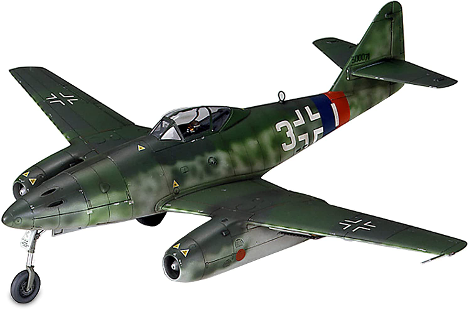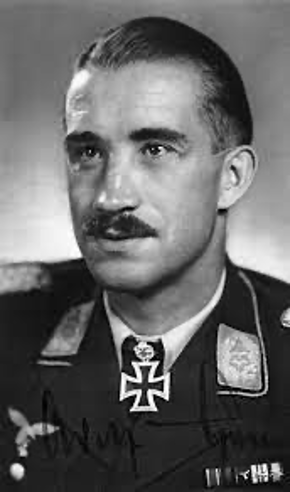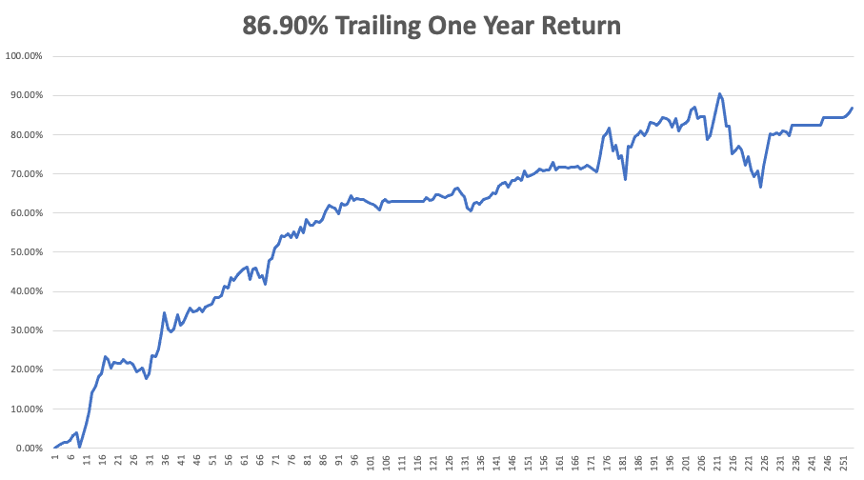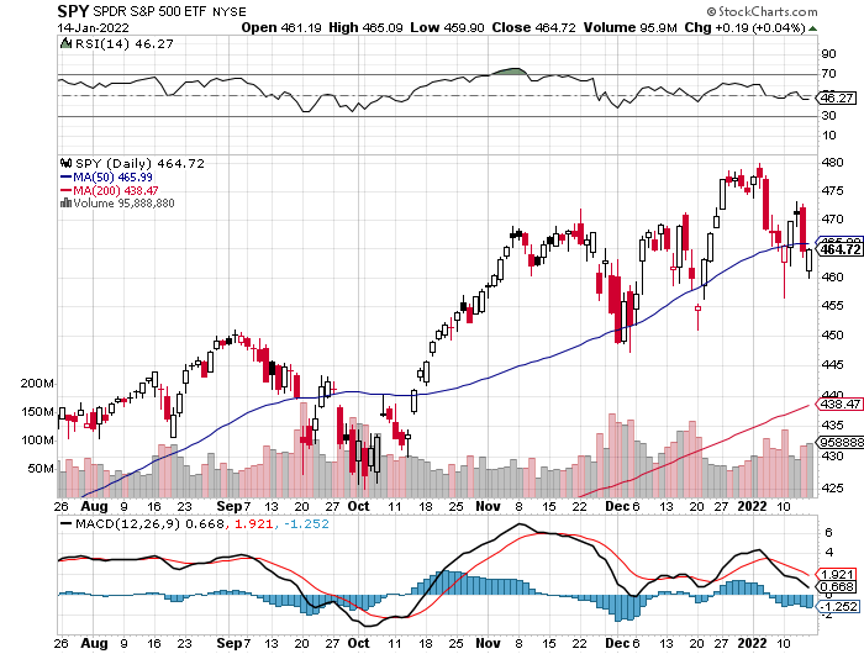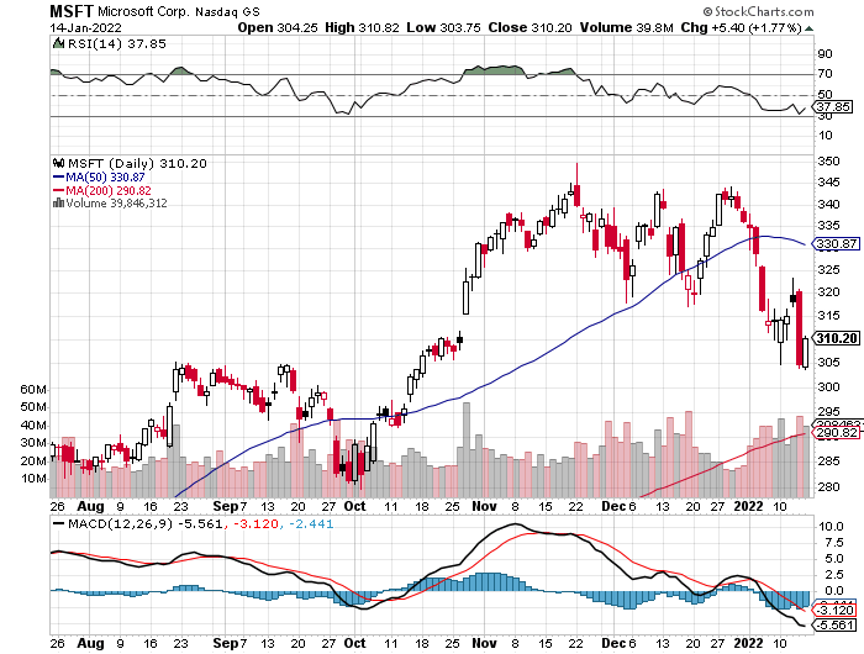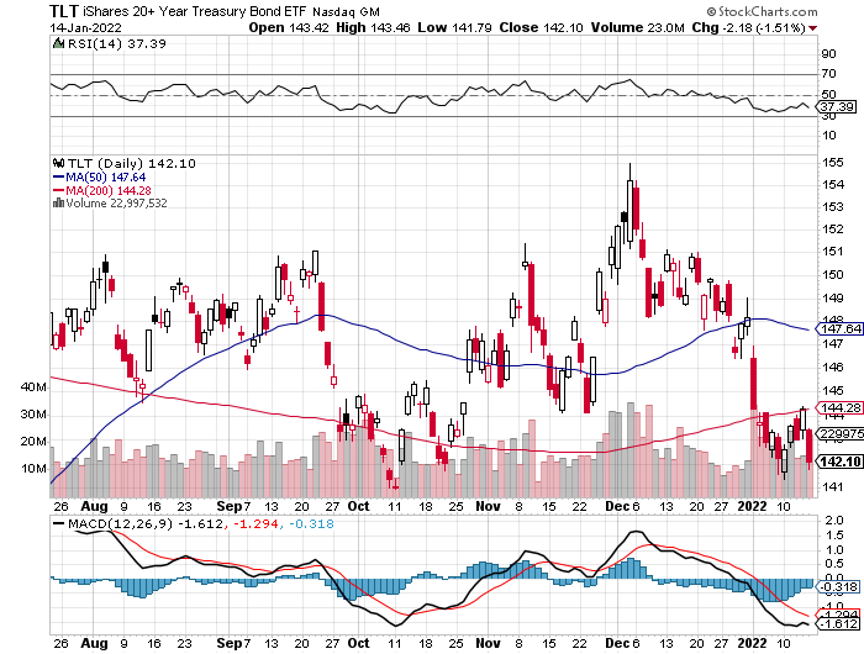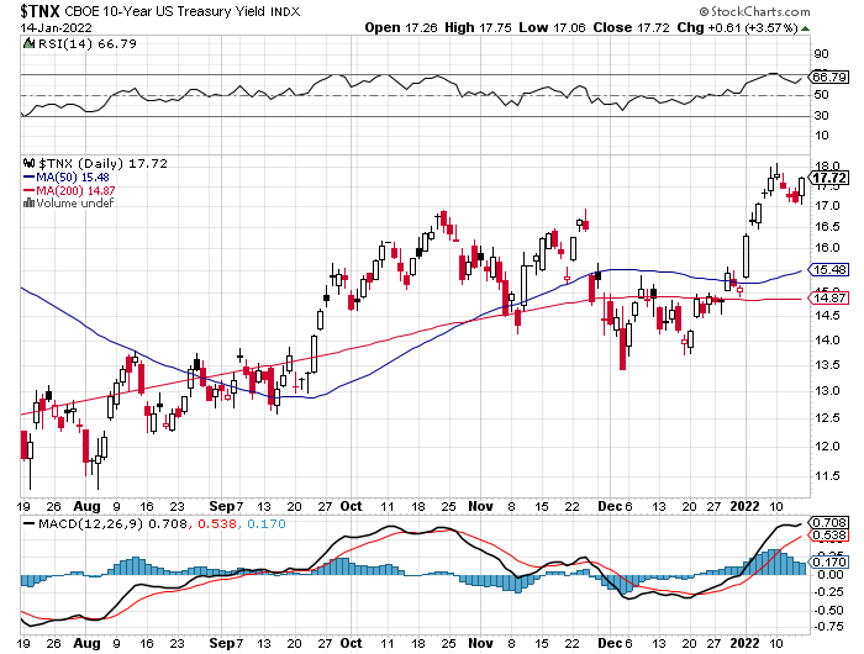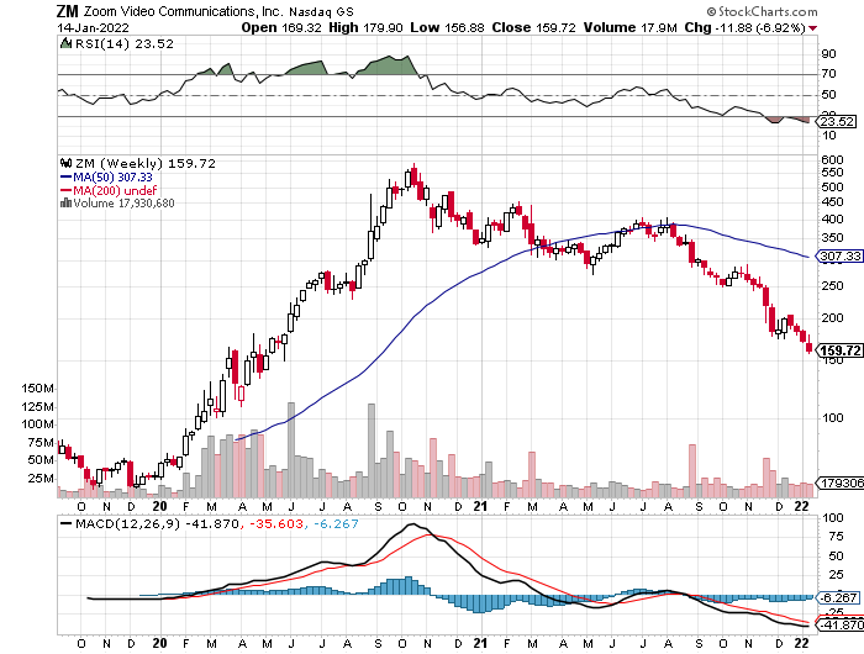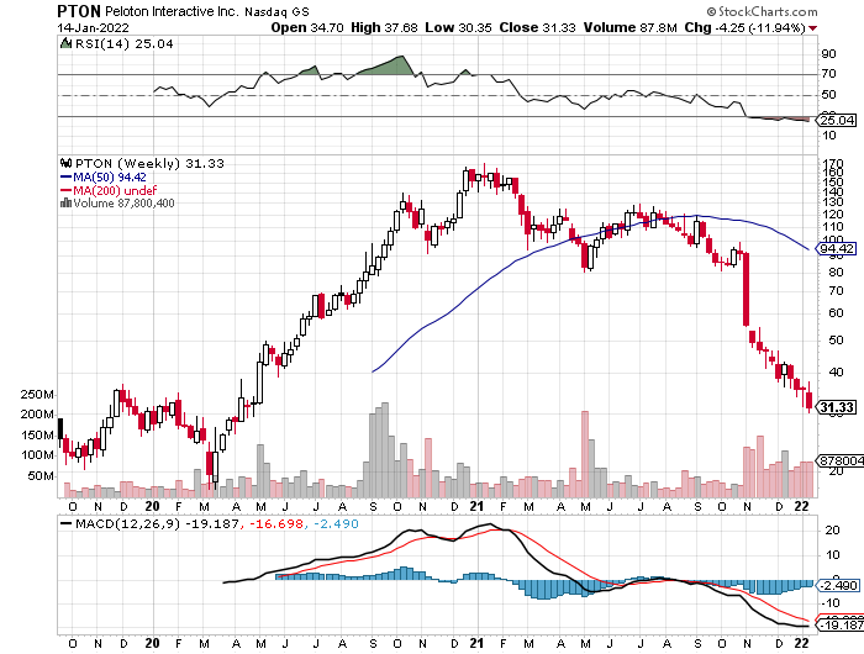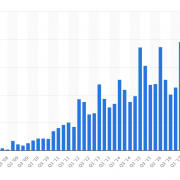Here I am, locked up again. Another day, another pandemic. There is nothing left for me to do but think.
When I turned negative on technology stocks at the end of November, many readers protested, accusing me of high treason, sedition, perfidy, and insisted I be hung from the nearest lamppost.
After last week’s drubbing on technology stocks, those claims are fading fast.
As a math graduate from UCLA, I can tell you it’s not about incompetence, delusion, or dementia, it’s simply all about the numbers.
Over the last five years, the S&P 500 (SPY) rose by 2X, while NASDAQ jumped by 3X, a 50% premium to the main market.
Most of this outperformance was due to multiple expansions. As interest rates fell further and further, investors were willing to pay ever more for tech stocks. As a result, 30% of tech stocks lose money and 30% trade for a nosebleed 10X sales or more.
Roll the interest rate move in reverse, and the tech premium disappears in a puff of smoke. And that has been happening with a vengeance since early December, with yields on the ten-year US Treasury bond soaring an eye-popping 58 basis points, from 1.34% to 1.82%.
Tech stocks are also coming off a pandemic tailwind of hurricane force. Now that every home in the country is equipped with four home offices and the hardware and software to support them, the turbocharger is failing.
Apple (AAPL) is a perfect example. From 2015 to 2019, Steve Jobs creation grew earnings by an average of 4% a year. Then the perfect storm hit, and earnings grew by an astonishing 60% in 2021. That delivered a gobsmacking 58% gain in the share price since March.
Tech momentum is now dead. In two-thirds of the tech market, a Dotcom bust has already played out, with non-earning pandemic darlings like Peloton (PTON) and Zoom (ZM) falling by 60%-70%.
It is not, however, the end of the world (usually, the world doesn’t end). If you are a long-term investor, big (earning) tech won’t fall enough to make it worth selling out and buying back lower. Non-earning small tech has already fallen so much it's no longer worth selling down here.
Back to the numbers, me the mathematician.
It’s all about margins, which are still expanding, and will be up by another 40-basis point in 2022 for the S&P 500 as a whole. For big tech, it’s just a matter of time before earnings catch up with valuations and it's off to the races again. It will take longer for small tech, possibly a lot longer.
The Economy is the Strongest in Decades, according to JP Morgan CEO Jamie Diamond. I agree. That’s because banks prosper most early in an interest-raising cycle. The Fed could raise rates four times this year. Keep buying financials on dips.
Quantitative Tightening to Start in July, says Goldman Sachs. That’s when the Fed starts selling its vast holdings of US Treasury bonds, about $8.5 trillion worth. They will continue QT until the pain becomes too great. Four rate hikes in 2022 are in the bag. It’s not a stock market-friendly scenario.
This is Not the Year to Own Money-Losing Tech, says my friend Goldman’s David Kostin. For investors, the glass has gone from half full to half empty. The big ones will be OK but are still due for a pullback. NASDAQ price-earnings are still at a 20 year high at 38X. Rising interest rates were the stick that broke the camel’s back. Don’t buy the dip too soon.
What is the Cheapest Sector in the Market? Biotech and Healthcare, which are at valuation lows not seen since the 2009 and 2000 lows. It also has the best decade-long growth outlook after technology. The problem is that no one wants to buy them on the back nine of a global pandemic. They will rally hard….someday.
Inflation Hits 7.0%, with the Consumer Price Index hitting a 39-year high. Bonds ended a $3.00 rally and resumed a downtrend. Rents and used cars led the gains. I remember 1982 well. My first home mortgage had an 18% interest rate. Expect worse to come.
S&P 500 Profits Jump 22.4% in Q4, possibly taking the full-year figure up an incredible 49%. It makes stocks look like a bargain, which were up only 27% in 2021. Expect cooler numbers and a quieter stock market in 2022.
Wholesale Prices Soar 9.7% YOY, the most in 11 years. It augers for more interest rate hikes sooner, with overnight rates targeting 1.25% by yearend.
Weekly Jobless Claims Hit Two-Month High at 230,000. No doubt it is due to the omicron surge. A million cases a day is certainly going to make a dent in the workforce. Some people are afraid to get sick, while others know they can get away with it.
Auto Stocks Will Be Top Performers in 2022, says value legend Mario Gabelli. Dealers are extremely short of inventory and demanding more production. Used car prices are soaring. Average industry sales prices have soared from $40,000 to $45,000 in a year. Buy (F) on a dip. (TSLA) has topped out for now with the rest of the tech stocks.
Bitcoin Breaks $40,000, as the flight from all interest-bearing securities continues. Don’t buy the dip yet.
China Posts Record Trade Surplus in 2021 at $676 billion on global economic recovery. The US ran a massive deficit with the Middle Kingdom last year, which is clearly dollar negative. None of the trade deals negotiated by Trump were honored. Exports were up 21% YOY in December.
My Ten-Year View
When we come out the other side of pandemic, we will be perfectly poised to launch into my new American Golden Age, or the next Roaring Twenties. With interest rates still at zero, oil cheap, there will be no reason not to. The Dow Average will rise by 800% to 240,000 or more in the coming decade. The American coming out the other side of the pandemic will be far more efficient and profitable than the old. Dow 240,000 here we come!
With a new year at hand, it’s off to the races once again. I exploded out of the gate with a hardy 2.5% profit last week. I used fleeting rallies to sell short the S&P 500, Microsoft (MSFT), and the bond market (TLT). The Friday collapse in JP Morgan (JPM) tempted me into a long position there.
Yes, last year’s mighty 90.02% performance is a lot to top. But even the highest mountain is climbed with the first step (been there, done that).
That brings my 12-year total return to a record 515.11%, some 2.00 times the S&P 500 (SPX) over the same period. My 12-year average annualized return has ratcheted up to a record 42.62%, easily the highest in the industry.
We need to keep an eye on the number of US Coronavirus cases at 66 million and rising quickly and deaths topping 851,000, which you can find here.
On Monday, January 17 markets are closed for Martin Luther King Day.
On Tuesday, January 18 at 7:00 AM, the NAHB Housing Index for January is released.
On Wednesday, January 19 at 8:30 AM, Housing Starts for December are announced.
On Thursday, January 20 at 7:00 AM, the Existing Homes Sales for December are printed. At 8:30 AM, the Weekly Jobless Claims are disclosed.
On Friday, January 21 at 2:00 PM, the Baker Hughes Oil Rig Count is out.
As for me, during the 1980s, my late wife and I embarked on a National Geographic Expedition to the remote Greek islands, including Santorini, which in those days didn’t have an airport.
At dinner, we sat at our assigned table and I noticed that the elderly gentleman next to me spoke the same unique form of High German as I. I asked his name and he replied “Adolph.”
And what did Adolph do for a living? He was a pilot. And what kind of plane did he fly?
A Messerschmitt 262, the world’s first jet fighter.
What was his last name? Galland. Adolph Galland.
I couldn’t believe my luck. Adolph Galland was the most senior Luftwaffe general to survive WWII. He was one of Germany’s top aces and is credited with 109 kills. He only survived the war because he was shot down during the final weeks and ended up in a military hospital.
And that was the end of the cruise for the rest of the table, as Galland and I spent the rest of the week discussing the finer points of aviation history.
It was made especially interesting by the fact that I had already flown most of the allied planes that Galland went up against, including the P51 Mustang and the Spitfire.
Galland started life as a Versailles Treaty glider pilot and joined the civilian airline Lufthansa in 1932. He transferred to the Luftwaffe in 1937 to fight with Franco in the Spanish Civil War and participated in the invasion of Poland in 1939.
He flew a Messerschmitt 109 as cover for German bombers during the Battle of Britain. In 1941, he was promoted to the general in charge of Germany’s fighter force until 1945 when he was sidelined due to his opposition to Goring and Hitler.
It was a fascinating opportunity for me to learn many undisclosed historical anecdotes. Germany actually had a functioning jet fighter in 1939. But Hitler, with a WWI mindset, diverted development money to twin-engine bombers and artillery.
The army eventually produced a canon that fired a monster one-meter-wide shell but was so heavy that it needed double railroad tracks to move anywhere. The canon was virtually useless in a modern war and was a colossal waste of money. Galland believed the decision cost Germany the war.
The ME 262 was a fabulous plane. But it was too little too late. Of the 1,000 produced, 500 were destroyed on the ground and most of the rest during takeoff and landing.
A big problem with the plane was that its jet engines were made out of steel and would only last ten hours. Turkish titanium needed for longer-lived engines was embargoed by the allies.
Today, a beautiful example hangs from the ceiling of the Deutsches Museum in Munich.
Galland negotiated the handover of his jet fighter wing to the Americans from a hospital bed so they could be used in an imminent war against the Russians. The atomic bomb ended that idea.
Galland was one of the few German generals never subjected to a war crimes trial. Pilots on both sides saw themselves as modern knights of the air with their own code of conduct. Parachuting pilots were never attacked and lowering your landing gear was a respected sign of surrender.
After the war, Galland emigrated to Argentina to train Juan Peron’s Air Force. He also test flew Gloster Meteor jets for the Royal Air Force. He participated in the 1972 film, The Battle of Britain and many WWII memorials. By the time I met him, his eyesight was failing. He died in 1996 at 84 of natural causes.
I give thanks to the good luck I had in meeting him, and that I had the history behind me to understand the historical figure I was sitting next to. It isn’t everyone that gets six dinners with Germany’s top fighter ace.
A year later saw me on a top-secret mission flying from Cyprus back to the American airbase at Ramstein. I plotted my course directly over Santorini.
When I approached the volcanic island, I put my Cessna 340 into a steep descent, dove straight into the mouth of the volcano, and leveled out at 100 feet above the water, no doubt terrifying the many yachts at anchor.
Greek Military Air Control gave me hell, but it was my own private way of honoring the principlals of Adolph Galland.
Stay Healthy.
John Thomas
CEO & Publisher
The Diary of a Mad Hedge Fund Trader


